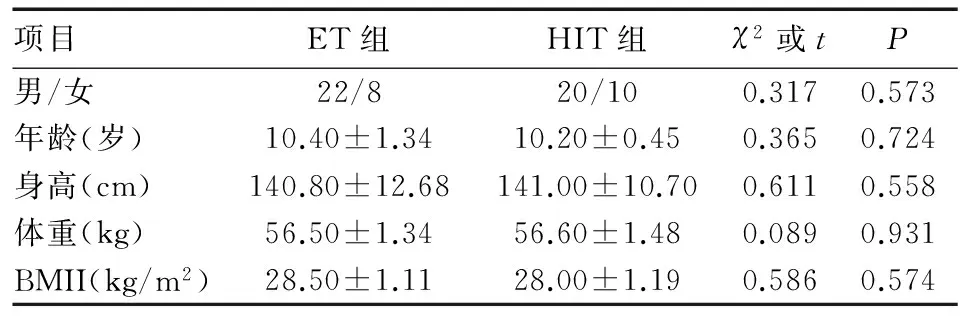耐力训练与高强度间歇训练对肥胖儿童健康相关指标的影响
祖秀明
耐力训练与高强度间歇训练对肥胖儿童健康相关指标的影响
祖秀明
目的 探讨耐力训练和高强度间歇训练对8~12岁肥胖儿童健康相关指标的影响。方法 选取2011年3~8月在本科门诊就诊的符合纳入标准的儿童70例,随机分成耐力训练组(ET)34例和高强度间隔训练组(HIT)36例,ET组进行30~60 min运动强度达到个人最大心率80%的连续运动;HIT组进行60 s运动强度达到个人最大心率90%~95%的冲刺运动,中间穿插一个1 min 达50%个人最大心率运动,重复3~6次。分别于干预前和干预12 w后进行生理和生化指标的检测。结果 干预后组间比较显示,两组受试者身高、体重、BMI 、收缩压、舒张压、HDL、TC、TG、LDL差异无统计学意义(P>0.05);HIT组血糖、胰岛素、胰岛素抵抗指数明显低于ET组(P<0.05)。组内比较显示:ET组干预后体重、BMI、收缩压、血糖、胰岛素抵抗指数、LDL含量低于干预前(P<0.05),身高、HDL、舒张压、胰岛素、TC、TG含量与干预前相比差异无统计学意义(P>0.05);HIT组干预后体重、BMI、收缩压、舒张压、血糖、胰岛素、胰岛素抵抗指数、LDL含量低于干预前(P<0.05),身高、HDL、TC、TG含量与干预前相比差异无统计学意义(P>0.05)。结论 运动锻炼能有效改善儿童肥胖症状,高强度间歇训练与传统的耐力训练相比,能明显减少胰岛素抵抗,减少总运动量,缩短锻炼时间,有较好的推广价值。
肥胖;儿童;耐力训练;高强度;间歇训练
近年来,不良的生活方式和不恰当的饮食习惯使得儿童肥胖的发生率显著增加[1],并且常伴血脂异常、糖耐量受损等代谢功能紊乱[2],严重影响儿童良好的生长发育。研究显示,低到中等强度的耐力训练能有效改变肥胖儿童的血压、胰岛素抵抗和血脂异常等与健康相关的参数[3]。然而有研究表明,高强度间歇性训练对改善健康儿童[4]和代谢综合征患者[5]的健康状况具有很大作用。本研究旨在比较两种不同形式的运动锻炼对肥胖儿童健康相关指标的改善情况。
1 对象与方法
1.1 研究对象 选取2011年3~8月在本科门诊就诊的符合纳入标准的儿童70例,按照入院就诊日期的单双数分成耐力训练组(ET组)34例和高强度间隔训练组(HIT组)36例。纳入标准:年龄8~12岁;符合2004年《中国学龄儿童青少年超重、肥胖筛查体重指数值分类标准》[6]肥胖诊断标准;近3个月没有服用减肥药治疗;无严重的心脑血管、内分泌疾病、先天性代谢或遗传性疾病;没有参与任何规律的饮食干预或运动训练(除了每周两次的体育课)。
1.2 干预方法 向两组受试者及其家属讲解运动锻炼的目的及用途,取得受试者及家长同意并签署知情同意书,利用医院康复科提供的跑步机进行步行或跑步的锻炼,先进行5 min的热身,然后进入正式训练阶段,最后用5 min整理运动结束训练。利用跑步机上无线心率测量仪和间接热感应器连续记录运动过程中受试者的心率变化和能量消耗。
1.2.1 ET组 受试者进行连续30 min的耐力训练,运动强度达到个人最大心率(220-年龄[7])的80%;随着时间的推移,每3 w增加10 min运动时间,直到最后3 w运动时间达到60 min时结束。在每次运动结束时,监测心率变化。30~60 min/次,大约消耗热量(268.16±61.40)~(536.26±122.80)Kcal,2次/w,干预12 w。
1.2.2 HIT组 以1 min的中速运动(运动强度为最大心率的50%)作为开始,然后加快速度达到最大心率的90%~95%,继续保持这个效果60 s,然后减速到起始速度运动维持1 min为一个回合;紧接着又一个竭力冲刺60 s进入下一个回合。前3 w为3个回合,随着时间推移,每3 w增加1个回合,到最后3 w增加为6个回合。每次3~6个回合,约10~30 min,大约消耗热量(84.06±5.30)~(169.76±30.60)Kcal,2次/w,干预12 w。
1.3 检测指标 干预前1 d和干预12 w后第1 d,分别测试一次下述指标 (1)生理指标:两组同时进行,由专业人员运用电子体重计(受试者身穿T恤和短裤)和测距仪(直立位)按照《2005年全国学生体质与健康调研检测细则》[8]对受试者进行身高和体重的测量,用水银血压计测量静息状态下的收缩压和舒张压。(2)血生化指标:采集血样前要求禁食12 h,于次日清晨空腹抽取肘静脉血,采用Beckman(CX7)全自动生化分析仪测定总胆固醇(TC)、甘油三酯(TG)、高密度脂蛋白(HDL)、低密度脂蛋白(LDL)、空腹血糖、空腹胰岛素指标,并计算胰岛素抵抗指数[=空腹血糖(mU/L)×空腹胰岛素(mmol/L)/22.5]。TC和TG测定采用酶法,HDL和LDL测定采用匀相测定法。
1.4 统计学方法 采用SPSS 17.0软件包进行统计分析,计数资料比较用χ2检验,计量资料比较采用t检验,P<0.05为差异有统计学意义。
2 结果
2.1 一般情况 由于个人原因,干预过程中,对照组4人和实验组6人退出。最终对照组有30人、实验组有30人完成实验。两组受试者的人口学特征无显著差异(P>0.05,表1),具有可比性。

表2 两组干预前后生理和生化指标的比较(n=30)
注:与本组干预前比较,①P<0.05;与ET组干预后比较,②P<0.05

表1 两组一般人口学特征比较(n=30)
2.2 干预前后两组生理和生化指标的比较 干预后组间比较显示,两组受试者身高、体重、BMI、收缩压、舒张压、HDL、TC、TG、LDL含量差异无统计学意义(P>0.05);HIT组血糖、胰岛素、胰岛素抵抗指数明显低于ET组(P<0.05)。组内比较显示,ET组干预后体重、BMI、收缩压、血糖、胰岛素抵抗指数、LDL含量低于干预前(P<0.05);身高、HDL、舒张压、胰岛素、TC、TG含量与干预前相比差异无统计学意义(P>0.05);HIT组干预后体重、BMI、收缩压、舒张压、血糖、胰岛素、胰岛素抵抗指数、LDL含量低于干预前(P<0.05),身高、HDL、TC、TG含量与干预前相比差异无统计学意义(P>0.05)。见表2。
3 讨论
与摄食过多相比,体力活动过少更容易导致肥胖。看电视和玩电脑时间较长以及繁重的作业,都使得儿童肥胖发生率居高不下[9]。除了摄食限制外,运动锻炼一直被认为是治疗儿童肥胖的有效策略之一[10]。本研究显示,组内比较显示,ET组干预后体重、BMI、收缩压、血糖、胰岛素抵抗指数、LDL含量低于干预前(P<0.05);身高、HDL、舒张压、胰岛素、TC、TG含量与干预前相比差异无统计学意义(P>0.05);HIT组干预后体重、BMI、收缩压、舒张压、血糖、胰岛素、胰岛素抵抗指数、LDL含量低于干预前(P<0.05),身高、HDL、TC、TG含量与干预前相比差异无统计学意义(P>0.05),与Superko等[11]的研究结果一致。分析原因,可能是运动锻炼能够增加能量的消耗减少体内脂肪的积蓄,抑制脂肪细胞的积累,减少脂肪细胞的体积,减少脂肪沉积[12],从而使体重下降,然而体重的丢失又能使胰岛素抵抗减低[13],胰岛素敏感性的增强又会影响血液中TG、TC、LDL等脂质的含量[14],引起生化指标的变化。
本研究显示,干预后HIT组的血糖、胰岛素、胰岛素抵抗指数低于ET组(P<0.05),可能的原因是:运动强度是影响骨骼肌PGC-1α含量最重要的因素,高强度间歇训练中,较强的冲刺力量会使骨骼肌中PGC-1α mRNA表达和核易位较耐力训练组增加3倍,使得PGC-1α参与机体脂质氧化、抗氧化防御、葡萄糖摄取与利用、抗炎能力增强[15-16],降低了血液中葡萄糖的含量,增加了糖原贮存量、减少糖原利用率、减少了胰岛素的释放;同时使得骨骼肌中参与葡萄糖转运的GLUT4蛋白的含量较耐力训练组增加了2倍,增加了外周组织对胰岛素的敏感性,降低了胰岛素抵抗[17]。
研究发现,儿童更易接受时间较短的密集式训练,而不是长时间的连续运动[18]。高强度间歇训练与耐力训练相比,减少了时间消耗和总的运动量,但效果明显,受试者的依从性更好,值得推广。
[1] Styne DM.Childhood and adolescent obesity prevalence and signi-ficance[J].Pediatr Clin North Am,2001,48:823-854.
[2] Thompson DR,Obarzanek E,Franko DL,et al.Childhood overweight and cardiovascular disease risk factor:the National Heart,Lung,and Blood Institute Growth and Health Study[J].J Pediatr,2007,150(1):18-25.
[3] Donnelly JE,Blair SN,Jakicic JM,et al.American college of sports medicine position stand appropriate physical activity intervention strategies for weight loss and prevention of weight regain for adults [J].Med Sci Sports Exerc,2009,41:459-471.
[4] Baquet G,Gamelin FX,Mucci P,et al.Continuous vs interval aerobic training in 8- to 11-year-old children[J].J Strength Cond Res,2009,24:1381-1388.
[5] Tjonna AE,Lee SJ,Rognmo O,et al.Aerobic interval training versus continuous moderate exercise as a treatment for the metabolic syndrome:a pilot study[J].Circulation,2008,118:346-354.
[6] 中国肥胖问题工作组.中国学龄儿童青少年超重、肥胖筛查体重指数值分类标准[J].中华流行病学杂志,2004,25(2):97-102.
[7] 朱稼霈,王晓强,荣湘江.儿童青少年单纯性肥胖运动减肥机制及运动处方的研究[J].中国康复医学杂志,2007,22(6):566-569.
[8] 教育部体育卫生与艺术教育司,全国学生体质健康调研组.2005年全国学生体质健康调研工作手册[M].北京:高等教育出版社,2005:37-42.
[9] Ana Carolina Corte de Araujo,Hamilton Roschel,Andreia Rossi Picanço,et al.Similar health benefits of endurance and high-intensity interval training in obese children[J].PLoS One,2012,7(8):42747.
[10] Innis KJ,Franklin BA,Rippe JM.Counseling for physical activity in overweight and obese patients[J].Am Fam Physician,2003,67:1249-1256.
[11] Superko HR,Haskell WH.The role of exercise training in the therapy of hyperlipoproteinemia cardiology clinics,1997,5(2):285-294.
[12] 石磊.儿童肥胖症的防治策略的探讨[J].中国慢性病预防与控制,2002,10(4):1791.
[13] Samuelsson J,Goyysater A,Lindgarde F.Decreasing levels of tumors necrosis factor α and interleukin 6 during lowering of body mass index with orlistat or placebo in obese subjects with cardiovascular risk factors [J].Diabetes Obes Metab,2003,5(3):195-201.
[14] Nilsson PM,Nilsson JA,Hedblad B,et al.Sleep disturbance in association with elevated pulse rate for prediction of mortality:consequences of mental strain[J]?J Intern Med,2001,250:521-529.
[15] Little JP,Safdar A,Cermak N,et al.Acute endurance exercise increases the nuclear abundance of PGC-1α in trained human skeletal muscle[J].Am J Physiol Regul Integr Comp Physiol,2010,298:912-917.
[16] Little JP,Safdar A,Wilkin GP,et al.A practical model of low-volume high-intensity interval training induces mitochondrial biogenesis in human skeletal muscle:potential mechanisms[J].J Physiol,2010,588:1011-1022.
[17] Whyte LJ,Gill JM,Cathcart AJ.Effect of 2 weeks of sprint interval training on health-related outcomes in sedentary overweight/obese men[J].Metabolism,2010,59:1421-1428.
[18] Ratel S,Duche P,Williams CA.Muscle fatigue during high-intensity exercise in children[J].Sports Med,2006,36:1031-1065.
Effects of endurance training and high-intensity interval training on health-related indexs of obese children
Zu Xiuming
Department of Pediatrics,the People's Hospital of Lulong County,Hebei,066400,China
Objective To discuss the effects of endurance training(ET)and high-intensity interval training(HIT)on health-related parameters of obese children aged from 8 to 12 years.Methods 70 children of out-patient clinic from March,2011 to August,2011,in accordance with the inclusion criteria,were selected and randomly divided into 2 groups: ET group(n=34)and HIT group(n=36).The children in ET group performed a continuous exercise for 30 to 60 minutes with the exercise intensity to induce 80% of individual maximum heart beat,while the children in HIT group performed rush exercise for 60 seconds with the exercise intensity to induce 90% to 95% of individual maximum heart beat with an interpenetration of exercise for 1 minute with the exercise intensity to induce 50% of individual maximum heart beat,and repeated the exercise for 3 to 6 time.Physiological and biological and biochemical indexs were detected before intervention and 12 weeks after intervention.Results After intervention,there existed no statistical difference in height,weight,BMI,systolic blood pressure,diastolic blood pressure,TC,LG,HDL and LDL(P>0.05)between the 2 groups,but the index of blood sugar,insulin and insulin resistance index In HIT group were obviously lower than those in ET group(P<0.05).In ET group ,the weight,BMI,systolic blood pressure,blood sugar,insulin resistance index and LDL level after intervention were lower than those before intervention (P<0.05),while no difference of statistical significance was found in height,HDL,diastolic blood pressure,insulin,the levels of TC and TG compared with those before intervention(P<0.05).In HIT group,the weight,BMI,systolic blood pressure,diastolic blood pressure,blood sugar,insulin,insulin resistance index,LDL level after intervention were lower than those before intervention,while no difference of statistical significance existed in height,HDL,the level of TC and TG after intervention compared with those before intervention (P<0.05).Conclusions Both ET and HIT are effective in improving the symptoms of obese children,but HIT is more effective in reducing the insulin resistance,cutting down the total amount of exercise and shortening the involved time,and it is more worthy of wide performance.
obese;children;endurance training;high-intensity;interval training
066400 河北 卢龙,河北省卢龙县医院儿科
R 725/151.41
A
1004-0188(2014)04-0408-04
10.3969/j.issn.1004-0188.2014.04.023
2013-05-14)

